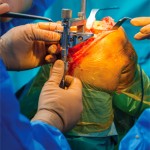“We know if you train before surgery you can improve outcomes. The surgical approach for both hips and knees does affect muscles, but if the muscles are strong, the patient will recover faster,” Dr. Iversen says. “That’s why preoperative physical therapy can be an important consideration to maximize function.”
Because patients with joint replacements are often discharged just two to three days after surgery, Dr. Iversen cautions that physical therapy needs to be planned early to avoid a gap in the provision of care that can increase the risk for the patient to lose movement and strength. “If a patient has a relationship with their physical therapist before the surgery, this is ideal.”
Carina Stanton is a freelance science journalist based in Denver.
References
- Kremers HM, Larson DR, Crowson CS, et al. Prevalence of total hip and knee replacement in the United States. J Bone Joint Surg Am. 2015 Sept 2;97(17):1386–1397. doi:10.2106/JBJS.N.01141.
- Nowell WB, Venkatachalam S, Harden E, et al. Patient decisions related to hip and knee arthroplasty and the factors influencing them [abstract]. Arthritis Rheumatol. 2016 Oct;68(suppl 10).
- Rooks DS, Huang J, Bierbaum BE, et al. Effect of preoperative exercise on measures of functional status in men and women undergoing total hip and knee arthroplasty. Arthritis Care Res. 2006 Sept;55(5):700–708. DOI:10.1002/art.22223.


